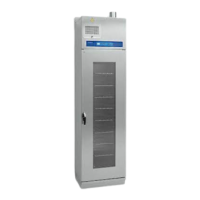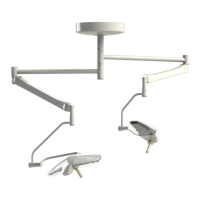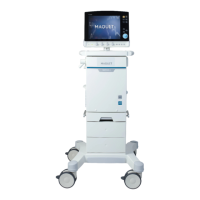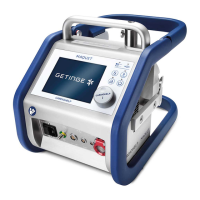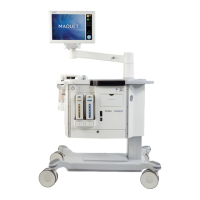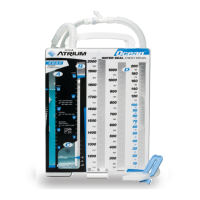Do you have a question about the Getinge HS 6613 ER-2 and is the answer not in the manual?
Explains warning, instruction, and advice symbols used in the manual for operator safety.
Illustrates and explains symbols for hot surface, electrical danger, and other dangers found on the unit.
Details the procedure for reporting accidents or incidents involving the sterilizer, including required information.
Introduces the HS 66 series of high-pressure autoclaves, their design, and intended use in health services and industry.
Details safety features like cladding, front panels, and lockable areas to prevent unauthorized access to internal components.
Explains that components ensuring safety are marked with a warning triangle and must be genuine GETINGE parts.
Describes door locking, emergency stop button, door interlock key, trim plates, and valve safety functions.
Covers design of pressure vessels, steam supply protection, and safety valves for pressure regulation.
Explains the automatic built-in steam generator, its heating power, and pressure controls.
Details control switches, pressure regulation stages, spark reduction, safety valve checks, and water level regulation methods.
Describes water level sensing, float-based systems, boil-dry protection, and overheat protection for the steam generator.
Covers overfilling protection, reset/test buttons, RCD, and safety switch for the steam generator.
Divides the universal steam autoclaving process into three main phases: Pre-treatment, Sterilizing, and Post-treatment.
Explains pre-treatment for air removal and moisture, and the sterilizing phase conditions measured by sensors.
Describes post-treatment for normalizing goods and process adaptation for optimizing results based on load type.
Details the automatic leak test procedure for steam autoclaves, including conditions and acceptable pressure rise.
Explains that a panel printer outputs logged process data for documentation.
Identifies and describes components on the loading side, including pressure gauges, control panel, and emergency stop.
Identifies and describes components on the unloading side, including recorder, pressure gauge, control panel, and emergency stop.
Guides the operator through starting a cycle, including selecting a cycle and loading goods.
Explains authorization for protected programs and lists various messages displayed to the operator regarding status or blocked operations.
Details how the system handles alarms, including visual/audible signals, and actions for a blowing safety valve.
Describes alarms occurring in standby mode and during a cycle, including silencing alarms and quick cycle stops.
Outlines steps for technician intervention, restarting cycles, and shutting off alarm indicators.
Covers repeated alarms, alarm printouts, door-related faults, and steam generator alarms.
Lists and explains various error codes (e.g., BATTERY ERROR, AI FAIL) and indicates when service is required.
Provides explanations for error codes related to temperature sensors, pressure, gasket, door, and pump failures.
Lists further error codes such as LOW TEMPERATURE, PHASE TIME OUT, MAINTENANCE, LEAK RATE FAIL, etc.
Offers general advice on using the sterilizer, including keeping doors closed and checking load materials.
Warns about fire hazards with textile loads and details weekly cleaning procedures for the Avanti model.
Describes how to clean the chamber and the purpose and procedure of Bowie Dick testing.
Describes how to stop a program or close a blowing safety valve using the EMERGENCY STOP button.
Outlines measures to take in case of an alarm, including silencing the alarm and handling emergency stops.
Lists approved consumables and provides guidance on packaging materials for steam sterilization, emphasizing EN868-1 standard.
Covers packaging for formaldehyde, test articles (chemical/biological indicators), and requirements for genuine GETINGE spare parts.
Explains CE label responsibilities and lists compatible accessories for extended documentation and loading equipment.
Provides day-to-day operating instructions, including restrictions on material processing and fire/hot surface warnings.
Details daily checks, preparing for a process, parameter passwords, and starting cycles via the Avanti panel.
Explains indicators for cycle completion, operating from the panel, and performing a process check.
Covers safe handling of hot goods after unloading and procedures for finishing work, including shutdown and cleaning.
Introduces the Programmable Autoclave Control System (PACS) and its role in controlling the unit and processing steps.
Defines special terms like STERILIZATION, STERILIZING, STERILIZATION TIME, PROCESS TIME, and PARAMETERS.
Describes the Avanti control panel, dividing its screen into status field, middle field, and button field.
Details the specific functions of the middle field and the application buttons in the button field of the Avanti control panel.
Explains the meaning of various indicators like 'Doors locked', 'Doors closed', 'Cycle in progress', 'Completed cycle', and 'Alarm'.
Lists and describes the functions of various buttons on the control panel, such as Help, Cycles, Home, Back, Alarm, Login, Logout, Menu, Save, Calibrate, Submit, Print, Start, Open.
Covers alarm handling, cycle information, messages, saving input, numeric/alphabetic keyboards, and cursor movement.
Explains scroll lists, button states (Active, Pressed, Not available, Ready to start), and the initial boot screen display.
Illustrates and explains alarm pop-ups, information pop-ups, and dialogue windows used on the control panel.
Describes window interactions, selection confirmation, and the green information window signalling process readiness.
Shows examples of inputting windows for names and times, detailing how to use keyboards and save entries.
Outlines the menu structure (Home, Main, System, Screen, Documentation, Alarm history) and how to start a cycle.
Explains how to select cycles, start the sterilizer, and manage user login/logout procedures.
Describes the start screen displays, including pie charts, cycle parameters, and bar graphs for parameters and time remaining.
Details the plot graph display showing various cycle parameters and time remaining, with parameters also shown in status field.
Explains the details graph for system and cycle information, and the documentation options for printing cycle data.
Describes how the alarm history displays the last 20 alarms, with details available for each alarm.
Lists available programs (P01, P02, P03) with their parameters and explains the door blocking key function.
Details programs for Bowie & Dick test (P04) and Automatic leak rate test (P05), including password requirements.
Explains warning, instruction, and advice symbols used in the manual for operator safety.
Illustrates and explains symbols for hot surface, electrical danger, and other dangers found on the unit.
Details the procedure for reporting accidents or incidents involving the sterilizer, including required information.
Introduces the HS 66 series of high-pressure autoclaves, their design, and intended use in health services and industry.
Details safety features like cladding, front panels, and lockable areas to prevent unauthorized access to internal components.
Explains that components ensuring safety are marked with a warning triangle and must be genuine GETINGE parts.
Describes door locking, emergency stop button, door interlock key, trim plates, and valve safety functions.
Covers design of pressure vessels, steam supply protection, and safety valves for pressure regulation.
Explains the automatic built-in steam generator, its heating power, and pressure controls.
Details control switches, pressure regulation stages, spark reduction, safety valve checks, and water level regulation methods.
Describes water level sensing, float-based systems, boil-dry protection, and overheat protection for the steam generator.
Covers overfilling protection, reset/test buttons, RCD, and safety switch for the steam generator.
Divides the universal steam autoclaving process into three main phases: Pre-treatment, Sterilizing, and Post-treatment.
Explains pre-treatment for air removal and moisture, and the sterilizing phase conditions measured by sensors.
Describes post-treatment for normalizing goods and process adaptation for optimizing results based on load type.
Details the automatic leak test procedure for steam autoclaves, including conditions and acceptable pressure rise.
Explains that a panel printer outputs logged process data for documentation.
Identifies and describes components on the loading side, including pressure gauges, control panel, and emergency stop.
Identifies and describes components on the unloading side, including recorder, pressure gauge, control panel, and emergency stop.
Guides the operator through starting a cycle, including selecting a cycle and loading goods.
Explains authorization for protected programs and lists various messages displayed to the operator regarding status or blocked operations.
Details how the system handles alarms, including visual/audible signals, and actions for a blowing safety valve.
Describes alarms occurring in standby mode and during a cycle, including silencing alarms and quick cycle stops.
Outlines steps for technician intervention, restarting cycles, and shutting off alarm indicators.
Covers repeated alarms, alarm printouts, door-related faults, and steam generator alarms.
Lists and explains various error codes (e.g., BATTERY ERROR, AI FAIL) and indicates when service is required.
Provides explanations for error codes related to temperature sensors, pressure, gasket, door, and pump failures.
Lists further error codes such as LOW TEMPERATURE, PHASE TIME OUT, MAINTENANCE, LEAK RATE FAIL, etc.
Offers general advice on using the sterilizer, including keeping doors closed and checking load materials.
Warns about fire hazards with textile loads and details weekly cleaning procedures for the Avanti model.
Describes how to clean the chamber and the purpose and procedure of Bowie Dick testing.
Describes how to stop a program or close a blowing safety valve using the EMERGENCY STOP button.
Outlines measures to take in case of an alarm, including silencing the alarm and handling emergency stops.
Lists approved consumables and provides guidance on packaging materials for steam sterilization, emphasizing EN868-1 standard.
Covers packaging for formaldehyde, test articles (chemical/biological indicators), and requirements for genuine GETINGE spare parts.
Explains CE label responsibilities and lists compatible accessories for extended documentation and loading equipment.
Provides day-to-day operating instructions, including restrictions on material processing and fire/hot surface warnings.
Details daily checks, preparing for a process, parameter passwords, and starting cycles via the Avanti panel.
Explains indicators for cycle completion, operating from the panel, and performing a process check.
Covers safe handling of hot goods after unloading and procedures for finishing work, including shutdown and cleaning.
Introduces the Programmable Autoclave Control System (PACS) and its role in controlling the unit and processing steps.
Defines special terms like STERILIZATION, STERILIZING, STERILIZATION TIME, PROCESS TIME, and PARAMETERS.
Describes the Avanti control panel, dividing its screen into status field, middle field, and button field.
Details the specific functions of the middle field and the application buttons in the button field of the Avanti control panel.
Explains the meaning of various indicators like 'Doors locked', 'Doors closed', 'Cycle in progress', 'Completed cycle', and 'Alarm'.
Lists and describes the functions of various buttons on the control panel, such as Help, Cycles, Home, Back, Alarm, Login, Logout, Menu, Save, Calibrate, Submit, Print, Start, Open.
Covers alarm handling, cycle information, messages, saving input, numeric/alphabetic keyboards, and cursor movement.
Explains scroll lists, button states (Active, Pressed, Not available, Ready to start), and the initial boot screen display.
Illustrates and explains alarm pop-ups, information pop-ups, and dialogue windows used on the control panel.
Describes window interactions, selection confirmation, and the green information window signalling process readiness.
Shows examples of inputting windows for names and times, detailing how to use keyboards and save entries.
Outlines the menu structure (Home, Main, System, Screen, Documentation, Alarm history) and how to start a cycle.
Explains how to select cycles, start the sterilizer, and manage user login/logout procedures.
Describes the start screen displays, including pie charts, cycle parameters, and bar graphs for parameters and time remaining.
Details the plot graph display showing various cycle parameters and time remaining, with parameters also shown in status field.
Explains the details graph for system and cycle information, and the documentation options for printing cycle data.
Describes how the alarm history displays the last 20 alarms, with details available for each alarm.
Lists available programs (P01, P02, P03) with their parameters and explains the door blocking key function.
Details programs for Bowie & Dick test (P04) and Automatic leak rate test (P05), including password requirements.
| Brand | Getinge |
|---|---|
| Model | HS 6613 ER-2 |
| Category | Medical Equipment |
| Language | English |

